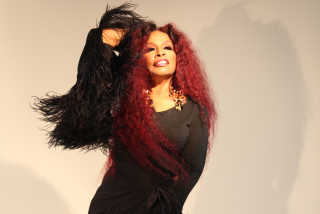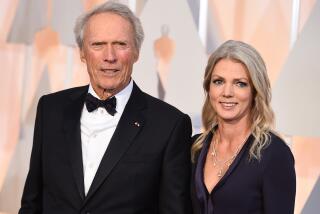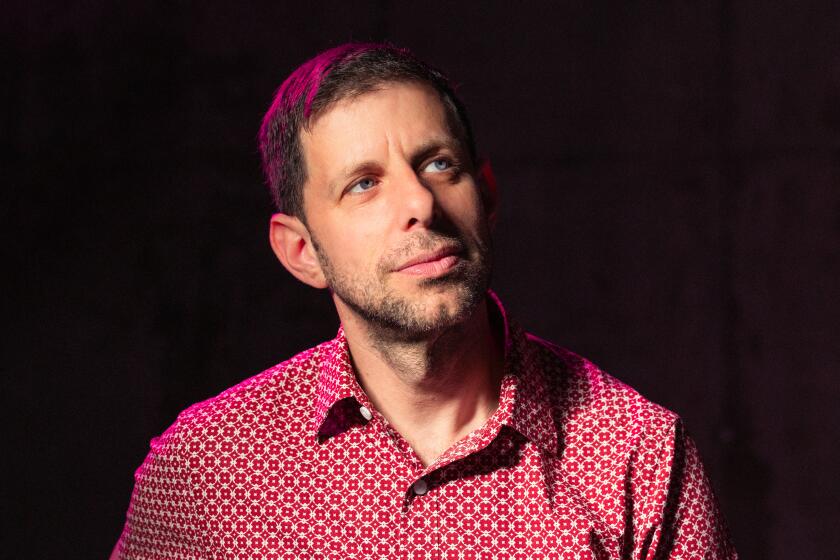ART REVIEWS : ‘History as Fiction’ a Provocative Show
“History as Fiction,” one of the summer’s most polemical group shows, declares that the attempt to capture the past for the future is always already doomed.
Buoyed by recent debates within post-structural theory concerning the relativity of truth and the impossibility of anchoring meaning, “History as Fiction” insists that experience can never be resurrected. It can only be reinvented, according to the whim of the inventor.
Artists have known this for a long time. What this very interesting exhibition at Meyers/Bloom Gallery makes clear is that not until recently has this knowledge been put in the foreground as the subject of their work.
Take the sculpture of Anne and Patrick Poirier, which serves as a manifesto of the exhibition. “Deep Memory (No. 5)” is the first piece one encounters, a high chest of pale, polished wood with four narrow drawers. Some are opened wide, others are nearly shut. One contains a magnifying glass; another, a book; a third, pages of parchment. A fourth is empty. On top sits a plaster cast containing the ruins of a miniature Greek temple.
What the piece suggests is that the edifice of history is about nothing so much as the historian, conjured here by her familiar tools: the looking glass, the volume, the document and the model. Where the past lies is not in the facts but, more dangerously, in ourselves.
The other artists in the show--Haim Steinbach, Kim Abeles, Guillaume Bijl, Juan Munoz, Meyer Vaisman, Braco Dimitrijevic, Annette Messager, Gloria Friedman and Wim Delvoye--approach these (mis)truths more elliptically. Steinbach offers his familiar Minimalist-inspired shelves laden with consumer objects--cornball mugs, oversize glass vases, kitschy wave-emulators--in order to interrogate both the gallery and the supermarket as repositories of a history of the present.
Bijl is also interested in how the mass-produced object doubles as artifact. His “Composition Trouvee (The Tibetan Store)” is a mock altar composed of souvenirs (a fringed garment, a quartet of multicolored hats, a pair of embroidered shoes and a brass incense holder), which materializes the tourist’s construction and fetishization of the ever-exotic Other.
“Fleur de Lys III,” one of Vaisman’s multilayered concoctions, juxtaposes a reproduction of an antique tapestry with a fading bolt of flowered fabric, and punctuates the whole with two glowing yellow mini-paintings of peeled banana skins. Here the question of history spins out into the equally thorny territory of taste. There, Vaisman suggests, no one is safe, for “quality” is always relative and subjective.
If history is a fiction, however, then art history is doubly so; for, while history packages experience, art history packages experience already packaged into form. Yet the show’s organizers (along with New York critic Dan Cameron, who penned the otherwise thoughtful catalogue essay) neither acknowledge the irony of their role as historians, nor do they question the thematic group show for its inevitable (intentional?) canonization of artists, movements and styles.
Here, for example, object-based Conceptualism--a very specific kind of art--is privileged. Photography, which has been instrumental in forging recent debates about representation, history and truth, is made marginal. And painting, whose post-modern or pastiche variant would fit quite nicely into the paradigm proposed by “History as Fiction,” is completely absent.
In one sense, this lack of self-criticality is a serious failing in a show that puts forth criticality as its premise. At the same time, it is probably naive to expect a commercial gallery to do otherwise. In either case, what predominates in the end is the pleasure of encountering so many provocative and provocatively installed objects in the space of a single show.
* Meyers/Bloom Gallery, 2112 Broadway, Santa Monica, (213) 829-0062, to Sept. 12. Closed Sunday and Monday.
Sierra Nevada Visions: At the Jan Turner Gallery, David Bungay’s crystalline visions of the Sierra Nevada wilderness claim that, yes, even in an age of fast-creeping conceptualism, it is still possible to paint a tree.
Of course, it all hinges upon what kind of tree and what kind of painting. Bungay can’t seem to make up his mind.
Some of his trees are thick strips of black and white that reconfigure the landscape as a series of graphic contrasts. Others are less extraordinary: brown saplings placed among wildflowers or ice-covered rocks.
Some of the paintings display the hyper-sophistication of geometrized form. Others embrace the hyperbolic ingenuousness of Sunday painting.
It sounds schizophrenic--and, in an important sense, it is. Bungay, like 20th-Century art in general, is infatuated with abstraction but can’t seem to let go of representation.
“Rainbow Trout” and “Rainbow Trout Grid” exemplify this duality. Here, an image of a single, luminescent fish is paired with a painting of a grid delineated in the same limpid greens and pinks, as if to insist upon the abstract or conceptual substructure of all representations. Stated this baldly, however, as an apologia for his own inconsistent brand of practice, Bungay’s repetition of art school truths seems merely self-serving.
Even more problematic is the veneer of eco-political consciousness that spottily coats the work. The melodramatic “No More Ducks” features a gelid landscape overlaid by white outlines of two ducks, like chalk tracings left behind at the scene of a crime. The maudlin “Rainbow Trout/Blue Plate on a Red Tablecloth” pleads for the innocent fish doomed to become this week’s blue plate special. “Antelope” is more strident, an image of the animal’s flayed skin spread out like a Rorschach blot, enjoining us to acknowledge complicity, to take responsibility.
Yet, why should we if Bungay does not? His vision of the landscape is entirely solipsistic. Nature is denatured in the service of art--purged of naturalistic detail, filtered through light of the clearest blue, form all but dissolving into a shimmering scrim of light and color.
Art is, of course, always about the ego of the artist. But when it presents itself as activism, it must also direct itself outward. The work in this exhibition suggests that Bungay may well become an interesting artist. But first, it’s imperative he decide just what kind of artist he wants to be.
* Jan Turner Gallery, 9006 Melrose Ave., West Hollywood, (213) 271-4453, to Sept. 21. Closed Sunday and Monday.
Celebration of Mexican Culture: “Mexico Escondido,” an exhibition of photographs shot in the remote villages and lush rain forests of Mexico, sidesteps the critical discourse in “History as Fiction” in order to defend documentary photographs as vehicles of truth.
Presented at the Los Angeles Photography Center as part of the Artes de Mexico Festival, “Mexico Escondido” is both timely and necessary, making visible a heterogenous culture that heretofore has been largely unseen--Mixtec women, Mayan Lacandon Indians, mestizo life in the Michoacan region, Afro-Mexicans living in the environs of Costa Chica.
The work of the 10 photographers showcased here--six from Mexico, four representing the United States--is uniformly strong, ranging from the romantic to the ironic, from the surreal to the plaintive. But this openly didactic exhibition directs the viewer to read those images as transparent, as reflections of Mexico’s richly diverse heritage, rather than as products of the artists’ particular artistic and political agendas.
In this, “Mexico Escondido” provides an object lesson as to how the photograph enters into circulation in the guise of history.
The double myth of the photographic document--its transparency and its objectivity--endures (just barely) in the work of the Mexican contingent. This is because the work of Gertrude Duby Blom, Marcey Jacobson, Micaela McGuirk, Barry Norris, Jose Angel Rodriguez and Antonio Turok Wallace tends, on the whole, toward the matter-of-fact, and away from the voyeuristic.
Blom is the elder stateswoman of the group, her dark-toned images of Lacandon Indians in the rain forests dramatic, but resolutely anti-sensational.
Wallace’s work, however, is more compelling, his varying pictorial formulas dictated not by a predetermined ideology but by his constantly shifting subject matter: mystical landscapes, stark portraits, chaotic street scenes. Particularly arresting is “Exodus 1982,” which isolates, amid a massive crowd that fills the image from frame to frame, a single figure with arms upraised, pleading for an unknown cause.
The myth of photography’s neutrality crumbles entirely in the work of the U.S. contingent--Jill Sabella, Hans Proppe, Tony Gleaton and Sian Li Kennedy. Sabella spent her early career as a researcher and photographer for National Geographic, and it shows. Her sepia-toned photographs of Mixtec women weavers at work, their looms strapped around their hips and their shirts conspicuously absent, read as virtual parodies of the magazine’s long-established penchant for safely exotic nudity.
Among the images Proppe captures are a rider in traditional costume galloping by an enormous Pepsi sign; a young girl sporting ceremonial wings striding past a ramshackle bus, and a massive crucifix being loaded into a Ford station wagon. He appears less interested, however, in exposing dichotomies of mestizo life than in exploiting them to create the ironic juxtapositions of which he is so fond.
Gleaton focuses his attention on Mexico’s black heritage, specifically Afro-American life in Costa Chica. One image is particularly moving: five little girls, sitting close together on a narrow bench, shyly clutching their blond-haired dolls. One wonders, however, if the image documents the plight of Afro-Mexicans or reflects Gleaton’s own experience as a black man in white America.
“Mexico Escondido” must be praised for its commitment to and celebration of Mexican culture. At the same time, it must be indicted for its refusal to foreground the work of these 10 artists as art--that is, as visionary and personal. In insisting upon the photographs as documents whose sole purpose is the dissemination of factual material about Mexican life, authorship is radically downplayed.
The installation of the work is such that it is difficult to determine where the work of one photographer ends and another begins. In this case, curatorial overzealousness performs a serious disservice to both artist and viewer.
* Los Angeles Photography Center, 412 Parkview St., (213) 389-7206, to Sept. 20. Closed Monday.
More to Read
The biggest entertainment stories
Get our big stories about Hollywood, film, television, music, arts, culture and more right in your inbox as soon as they publish.
You may occasionally receive promotional content from the Los Angeles Times.






